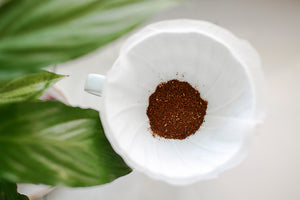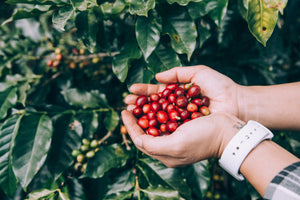
Why the material, shape and color of the cup you drink your coffee from impacts your perception of the flavour
When we’re sipping coffee, the way our brain combines a variety of stimuli into an entire experience determines how we perceive its flavour. Surprisingly, it’s not just our taste buds that are at work here. Vision, aroma, taste, and tactile senses are all included. A great cup of coffee is one of life's simple pleasures. That delicate aroma as you lift your coffee cup, that first sip as you take in the flavor notes for the first time...For coffee afficionados these moments are important. So, to what extent can you elevate these experiences by carefully choosing your coffee cup?
The standard coffee cup is created with one goal in mind: to serve hot liquids in a safe manner. To put it another way, we won't be burned if we drink coffee. This is the benchmark for coffee cup design. However, none of this reveals anything about the cup’s potential to enhance our coffee's flavors.
The Material of the Cup can affect the taste of your coffee
The material used to make the cup is a significant factor in attaining the optimum taste. While there are a variety of drinking cups available, ranging from plastic to metal to paper, the material you choose will alter the flavor of your coffee.
Your cup's material has a direct impact on the flavor of your coffee including its ability to keep it hot. According to professional baristas the following materials should be avoided:
Plastic
Plastic may appear to be an excellent choice due to its low weight and convenience, but it may easily absorb odors and flavors over time, leading your coffee to taste unpleasant. If you only drink one sort of liquid from your plastic mug, it's probably not a major concern; however, several coffee flavors can be absorbed by the plastic and skew the experience of drinking coffee.
Glass
Glass has a neutral taste, although it's still not the best material for offering the ultimate coffee experience. Glass is not a brilliant insulator so it will cool down quite quickly in a glass cup. And, because coffee loses its flavor as it cools, you’ll have to pretty speedy to enjoy it at its best.
Stainless Steel
Even though stainless steel a reliable material for reusable takeaway coffee cups, it nevertheless has the potential to impart flavours into your coffee. Additionally, there are some chemicals in coffee that react strangely with metal, so you can get some unusual flavours.
Why does coffee taste better when it's served in a ceramic mug?

It's natural instinct to judge quality by its surroundings, and using a ceramic mug usually suggests you're in a more pleasant environment. Because ceramic is a solid, flavorless substance that neither absorbs nor imparts tastes, it enables coffee to taste just as it should.
To say the least, our perception of taste is complex. Because so much of what we think of as flavour is actually smells or aromas, ceramic is the greatest choice because of its neutral properties. It also helps to insulate hot liquids, keeping your coffee at the optimum temperature for longer before cooling dulls its subtleties.
How do colors affect flavour perception of coffee?

Colour has a big impact on how people perceive the taste and flavor of coffee. According to one study, coffee served in a white cup is seen to be more intense than coffee given in a transparent mug.
Brown is thought to be associated with bitterness, therefore when a white cup is used; the "brownness" of the coffee is increased or at least more visible against the white background.
The science behind choosing the shape of your coffee cup
One study has discovered that shape of the drinking cup affects the consumer's impression of the flavour. Narrower mugs have more aromatics; shorter mugs or coffee were rate to have more bitter and powerful coffees, while wider mugs have sweeter flavors, according to study participants.
The space between the liquid and the top of the glass, is known as headspace. Although headspace isn't commonly mentioned in a normal coffee shop, we coffee lovers enjoy discussing fragrance. If there isn't much headroom, such as if the vessel is completely full, or if it is too thin to achieve a sharp tilt angle, there is little room for the aromatics of the coffee to be noticed. That isn't to say that narrow vessels are always a terrible idea; in fact, depending on the type of coffee you're drinking, they might be ideal.
In conclusion:
It’s clear there are some materials to avoid when it comes to drinking coffee. Opting for a decent ceramic cup or mug wherever possible will keep your coffee at optimum temperature and avoid imparting unwanted flavours into your brew.
A reusable takeaway cup is always better for the planet – and your taste buds - than disposable one but pay attention to the inner lining. Choose a ceramic or glass-lined one if possible.
Choosing a different coffee cup doesn’t change the flavour of the coffee, only our perception of it. This means there is no right or wrong vessel to enjoy your coffee from, though it’s worth noting your preferred flavours and choosing a cup or mug that enhances them:
Wide = sweeter
Narrower = more aromatic
Short = bitter and/or powerful
Take a look at our huge range of Loveramics coffee cups in all different shapes, sizes and colours to see which ones suit your flavour preferences. They’re all made of high-quality ceramic, so you already know you’re getting the optimum experience, whichever style you choose.



